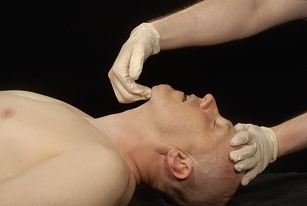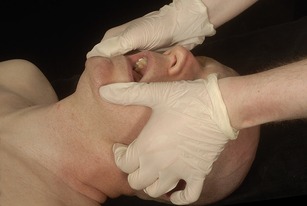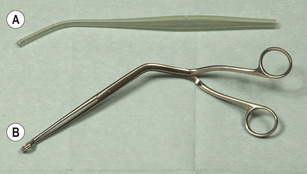CHAPTER 1. AIRWAY CARE WITH SIMPLE DEVICES
The first procedure used for airway control was probably tracheostomy. Pedro Virgili (1699–1776) from Cadiz used it for the relief of quinsy, but its popularity was assured by its success in the management of diphtheria. The first to use it in the UK for diphtheria was George Martine (1702–1741). The eminent surgeon Sir William MacEwen (1848–1924) first performed intubation of the upper laryngeal orifice and trachea in 1878 as an alternative to tracheostomy, again for the management of life-threatening airway obstruction due to diphtheria.
INTRODUCTION
The assessment of airway patency and its safeguard are essential skills for acute life-support. Recognition of an obstructed airway is initially manifested by a combination of ventilatory efforts and airway sounds reflecting airflow turbulence, which become relatively quickly complicated by the signs of inadequate respiratory function such as cyanosis, tachycardia, and loss of consciousness.
VENTILATORY EFFORT
• Increased accessory muscle activity.
• Mouth opening with each inspiratory effort.
• Suprasternal and chest wall indrawing rather than chest expansion with every inspiratory effort.
AIRWAY SOUNDS
• Stridor – a harsh noise produced on aggressively trying to inspire air to overcome an obstruction at or above the level of the larynx.
• Wheeze – a sound heard at the mouth or on chest auscultation during expiration.
— The pitch of the wheeze may be described as polyphonic, commonly observed in asthma and chronic obstructive airways disease. This sound suggests many airways of differing calibre are simultaneously in varying states of compromise due to spasm and/or narrowing secondary to mucosal inflammation. The wheeze of asthma is easily heard at the mouth and confirmed by chest auscultation.
— Wheeze with a single sound (monophonic) particularly located in just one area indicates obstruction of a single bronchus, e.g. by tumour. The fixed wheeze (also called rhonchus) of bronchial obstruction is not e asily heard at the mouth.
• Crowing – a loud sound heard with every inspiration not dissimilar to stridor and suggests turbulent flow due to flow through a narrow orifice commonly heard during laryngeal spasm.
• Gurgling – the sound of air bubbling through liquid or semi-solid debris in the upper airways is mostly heard during inspiration.
• Snoring – a long inspiratory sound associated with partial occlusion of the pharynx by the tongue or soft palate.
 Tip Box
Tip BoxAn obstructed airway is a clinical emergency. If you are not confident in managing the airway, call for immediate anaesthetic assistance.
AIRWAY MANAGEMENT
AIRWAY CLEARANCE
Look inside the oral cavity and remove any vomitus, debris or foreign bodies with the following devices:
• Yankauer sucker (Fig. 1.1 A) – a rigid suction device that is attached to a vacuum collection system for facilitating removal of liquid or semi-solid debris from the oropharynx.
• Magill’s forceps (Fig. 1.1 B) – in the acute setting these are used to remove foreign bodies from the oral cavity. Magill’s forceps are also used to guide nasogastric tubes into the oesophagus under direct vision and to place pharyngeal packs.
BASIC AIRWAY TECHNIQUES
• Head tilt, chin lift (Fig. 1.2): avoid if suspected cervical spine trauma – place one hand on the patient’s forehead and the fingertips of your other hand under the patient’s chin. Whilst gently tilting the head back lift the patient’s chin to open the airway.
 |
| Fig. 1.2 |
• Jaw thrust (Fig. 1.3) – this is the technique of choice in the presence of suspected cervical spine injury. Place the index fingers behind the angle of the mandible and apply steady upwards pressure to bring the mandible forwards. Slightly open the mouth by downwards displacement of the chin with your thumbs.
 |
| Fig. 1.3 |
 Tip Box
Tip BoxSuspected C-spine injury – The jaw thrust is the technique of choice in such patients for basic airway management, with manual in-line stabilization of the head and neck performed by a second operator. However, the primary and over-riding objective in all cases is the maintenance of a patent airway as an obstructed airway is the most immediate threat to life.
Stay updated, free articles. Join our Telegram channel

Full access? Get Clinical Tree



